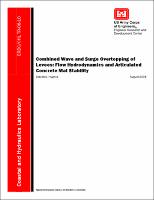Please use this identifier to cite or link to this item:
https://hdl.handle.net/11681/7654| Title: | Combined wave and surge overtopping of levees: flow hydrodynamics and articulated concrete mat stability |
| Authors: | Hughes, Steven A. |
| Keywords: | Concrete mats Erosion control Levees Simulation modeling Soil stabilization |
| Publisher: | Coastal and Hydraulics Laboratory (U.S.) Engineer Research and Development Center (U.S.) |
| Series/Report no.: | ERDC/CHL TR ; 08-10. |
| Description: | Technical report A 1-to-25 scale physical model of a typical cross section of the levee along the Mississippi River Gulf Outlet (MRGO) was constructed at the U.S. Army Engineer Research and Development Center’s Coastal and Hydraulics Laboratory in Vicksburg, MS. The purpose of the physical model was to obtain hydrodynamic measurements of unsteady flow conditions caused by combined wave and surge overtopping of the levee, and to examine the feasibility of using articulated concrete mats (ACMs) for levee protection during this type of overtopping event. Specifically, the U.S. Army Engineer District, New Orleans, was interested in determining whether the same ACMs used by the Corps’ Mat Sinking Unit to protect river banks could be used to protect the MRGO levee against surge and wave overtopping. When the storm surge elevation was 0.75 ft above the levee crest, the stability tests indicated the ACMs were prone to uplift on the lower portion of the levee protected-side slope for even relatively mild wave overtopping. An increase in wave height created mat roll- up instability at the toe of the flood-side levee slope, indicating the need to bury or anchor the leading and tailing edges of the mats. Mat stability could be increased with additional anchoring or increasing mat thickness. Tests were also conducted to document the hydrodynamics associated with combined wave and surge over-topping. The primary parameters were three overtopping surge levels (+1, +3, and +5 ft); three significant wave heights (3, 6, and 9 ft); and three peak wave periods (6, 10, and 14 sec) for a total of 27 unique conditions. Measurements included the incident irregular waves and time series of water elevations at seven locations on the crest and protected-side slope of the levee. Horizontal flow velocity was recorded near the leeward levee crest shoulder, and the velocity was then combined with water elevation to estimate the unsteady instantaneous discharge over the levee. Discharge cumulative probability distributions were determined using the Weibull probability distribution, and a predictive equation was developed for the distribution of overtopping discharge as a function of wave and surge parameters. |
| Rights: | Approved for public release; distribution is unlimited. |
| URI: | http://hdl.handle.net/11681/7654 |
| Appears in Collections: | Technical Report |
Files in This Item:
| File | Description | Size | Format | |
|---|---|---|---|---|
| CHL-TR-08-10.pdf | 4.85 MB | Adobe PDF |  View/Open |